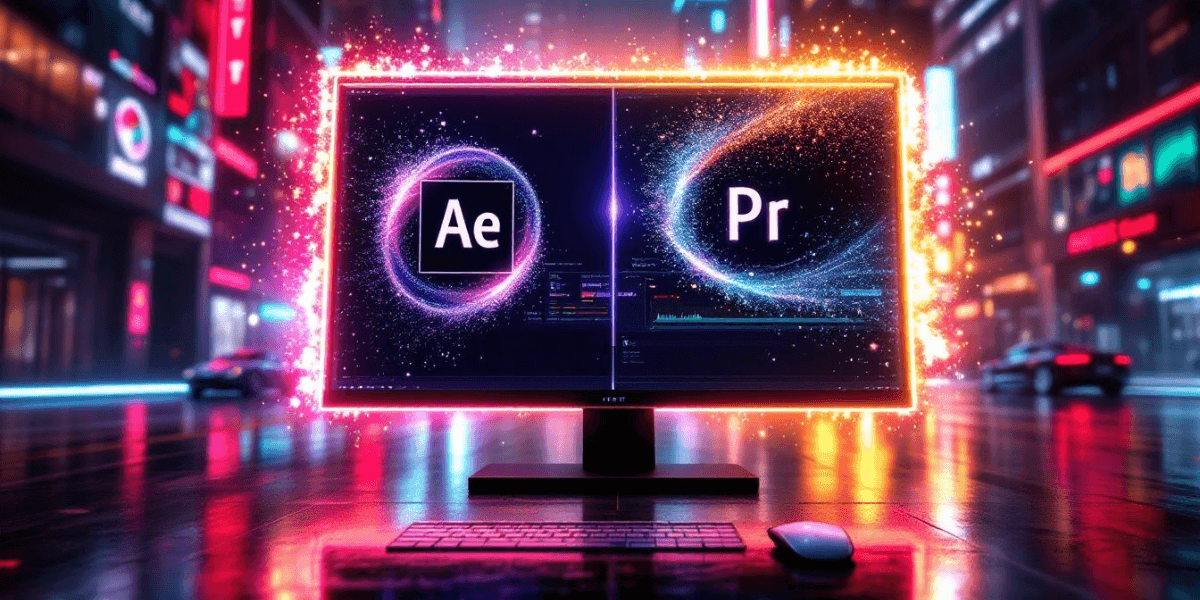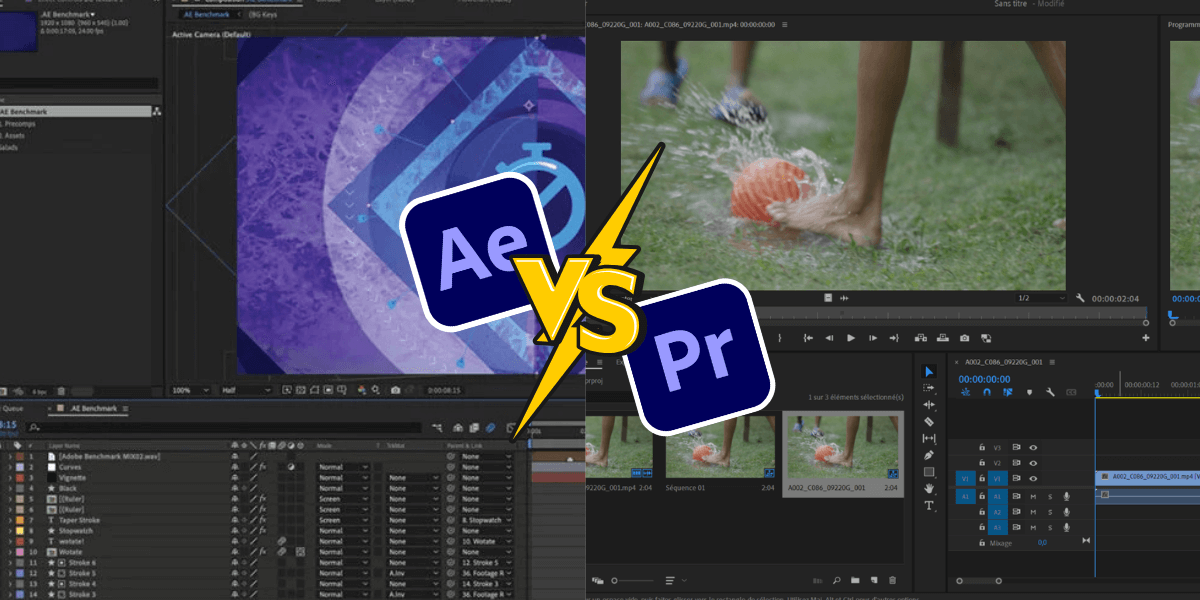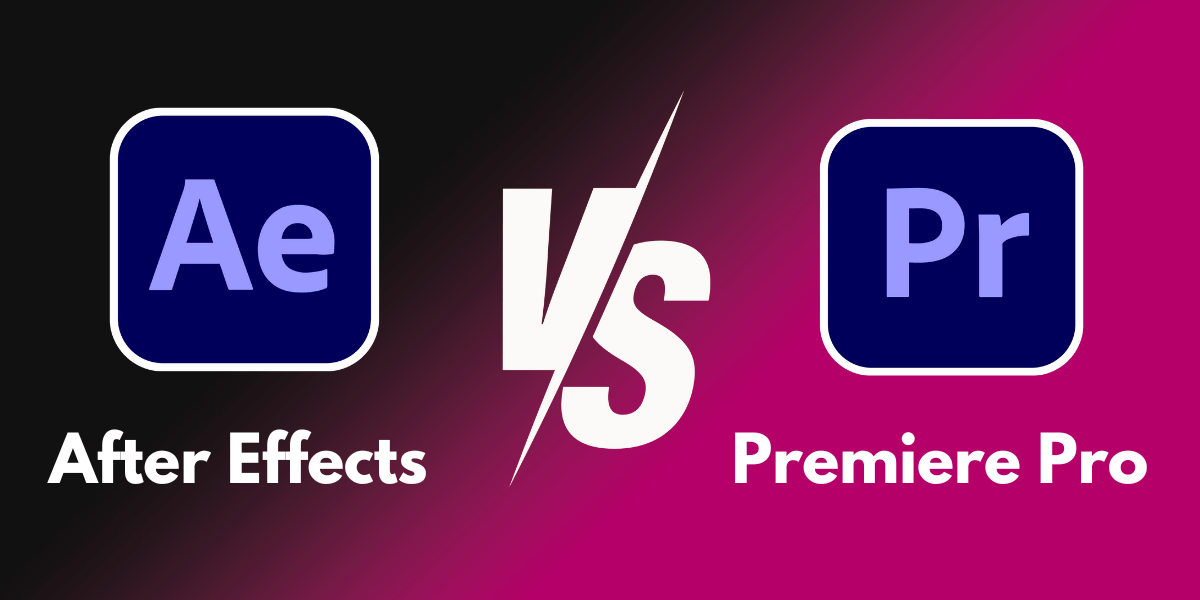Home > After Effects vs Premiere Pro: Which One to Choose?
In the world of video production, Adobe Premiere Pro and After Effects are two essential pillars for professionals and enthusiasts alike. Premiere Pro shines with its non-linear video editing capabilities, perfect for assembling, cutting, and refining your sequences with ease. On the other hand, After Effects stands out with its spectacular visual effects and stunning graphic animations, adding a unique artistic dimension to your projects.
Why choose one over the other when their combination offers unparalleled synergy? Discover how these complementary tools can transform your creations and boost your productivity with innovative features. Whether you are an editor or a motion designer, mastering these tools unlocks a boundless creative universe.

Adobe Premiere Pro and After Effects are two video editing software tools from the Adobe suite, each offering its own advantages and specializations. Premiere Pro is primarily designed for non-linear video editing and post-production, making it a popular choice among professional editors. On the other hand, After Effects is used to create captivating motion graphics and sophisticated visual effects, adding a dynamic dimension to video projects.
Understanding the differences between these two programs is crucial for choosing the right tool for your projects. Premiere Pro excels in cutting and assembling video sequences, while After Effects stands out for its compositing and animation capabilities.
By combining the strengths of these two software tools, you can achieve impressive results.

Adobe Premiere Pro is a non-linear video editing software widely used for editing and post-production. With its ability to handle quick and efficient edits, including cutting and assembling sequences, as well as adjusting audio and visual quality, Premiere Pro is a preferred tool for professionals and hobbyists alike.
The intuitive interface of Premiere Pro makes it particularly suitable for simple projects, allowing users to focus on editing without being overwhelmed by complex options. For standard editing tasks, Adobe Premiere Pro offers a robust and easy-to-use solution.
After Effects is primarily used to add special effects and animated graphics after basic edits, creating a striking visual impact. This software is particularly valued for its ability to create advanced graphic animations, making it a preferred tool in the film and television industries.
While Premiere Pro focuses on video editing, After Effects excels in animation creation and visual effects. After Effects’ capabilities to transform video sequences with dynamic visual elements make it an essential choice for projects requiring sophisticated animations.

Premiere Pro is a versatile tool widely used in various video editing contexts. Here are some of its main uses:
Premiere Pro adapts to a wide range of video production scenarios.
Its use also extends to improving the quality of video footage, regardless of the camera used.
Premiere Pro enables precise adjustments to cuts, transitions, and the rhythm of a video, providing full control over editing. With its scene edit detection feature, it can automatically identify and cut different scenes in a video, greatly simplifying the editing process.
The intuitive interface of Premiere Pro makes it easy to trim, rearrange, and synchronize video clips. These tools allow for high-quality editing to be completed quickly, making Premiere Pro ideal for projects requiring fast and efficient modifications.
Premiere Pro supports various editing tasks, including importing clips and adjusting timelines. This software also facilitates adding sound and images, enabling a coherent and high-quality video editing process.
The color management tools in Premiere Pro quickly optimize video sequence editing. With its support for editing in multiple formats, from standard definitions to high-resolution 8K videos, Premiere Pro provides exceptional flexibility for various post-production projects.

After Effects is a powerful software used to create impressive motion graphics and complex visual effects. Its advanced tools allow users to manipulate and transform video sequences creatively and dynamically, adding a new dimension to video projects.
After Effects enables users to create detailed animations and visual effects that enhance video projects. Whether animating text, images, or 3D objects, After Effects offers an extensive range of tools to bring your ideas to life.
The possibilities for motion graphics with After Effects are virtually limitless. Users can create complex animations that captivate the audience, adding unique depth and dynamism to videos.
After Effects is widely used to create complex animations and visual effects that enhance video content. With its layer-based system, After Effects allows for the creation of intricate compositions, offering increased flexibility for visual effects.
For projects requiring sophisticated visual effects, After Effects is often the software of choice. Its advanced features enable specific tasks that are not achievable with Premiere Pro, making After Effects indispensable for projects demanding high-quality visual effects.

The integration of After Effects features into Premiere Pro simplifies the work of editors by allowing them to stay within their editing environment. By using Premiere Pro and After Effects simultaneously, you can optimize the video creation process by combining the strengths of both software.
Premiere Pro offers a detailed timeline interface, facilitating technical editing, and allows for more extensive customization of its interface layout, which can enhance efficiency during editing. This interface, with its customization options, contrasts with After Effects’ simpler yet equally effective design for accessing specific controls depending on the selected element.
Premiere Pro’s interface is particularly advantageous for projects requiring precise timeline management, while After Effects’ interface is more focused on layer manipulation and visual effects.
Adobe Premiere Pro is renowned for its advanced color correction tools, making it suitable for a variety of video editing styles. The text-based editing feature allows for generating transcripts and integrating sequences based on selected text, enhancing precision and editing efficiency.
After Effects, on the other hand, can significantly enhance videos by adding advanced visual effects that bring dynamic quality to sequences. While Premiere Pro offers robust tools for editing, After Effects excels in the manipulation of animations and visual effects.
After Effects generally requires more powerful hardware configurations due to its resource-intensive nature for rendering animations. For optimal use, it is recommended to have at least 16 GB of RAM for After Effects.
On the other hand, Premiere Pro utilizes the Mercury playback engine, enabling real-time accelerated playback, which optimizes the editing workflow compared to After Effects, providing an advantage. This performance optimization allows users to work efficiently even on less powerful hardware configurations.

The combined use of Premiere Pro and After Effects allows users to leverage the strengths of each software, optimizing the workflow and video production process.
Premiere Pro and After Effects are designed to work together seamlessly. This is facilitated by the Dynamic Link feature, allowing users to switch between applications without complications. This integration enables users to import After Effects compositions directly into Premiere Pro and make real-time adjustments visible immediately in Premiere Pro.
Dynamic Link eliminates the need for repetitive exports between the two software, significantly speeding up the workflow. Users can work on After Effects layers while editing the timeline in Premiere Pro, enabling better multimedia resource management and more effective collaboration.
Collaboration on projects is greatly enhanced by the integration of Premiere Pro and After Effects through Dynamic Link. Changes made in After Effects appear instantly in Premiere Pro without the need for intermediate renders. This enables teams to work more seamlessly and reduces waiting times, thereby improving overall project efficiency.
Features like dynamic text templates from After Effects, which can be edited directly in Premiere Pro, simplify text updates without having to return to After Effects. By combining these tools, users can collaborate more efficiently. For example, by copying and pasting elements between the two software programs for improved workflow fluidity.

The choice between Adobe Premiere Pro and After Effects largely depends on the video project’s objectives and the complexity of the tasks to be performed.
Each of these software programs offers specific features tailored to different needs, making it crucial to understand the strengths and weaknesses of each tool to make an informed choice.
Premiere Pro is ideal for simple projects requiring standard editing elements, such as cutting, assembling sequences, and adjusting audio and visual quality. Its intuitive interface and fast editing tools make it particularly suitable for straightforward, linear editing.
Conversely, After Effects is better suited for more complex projects that require animations and sophisticated visual effects. After Effects’ animation tools enable the creation of smooth movements and bring graphic elements to life, which is essential for animating logos or characters.
The choice of software should take into account specific needs, such as the level of detail required in the editing or the sophistication of the desired visual effects. If precise editing is crucial, Premiere Pro is generally preferred, whereas After Effects excels in creating complex visual effects.
For example, for projects requiring advanced color manipulation or dialogue optimization, Premiere Pro offers robust tools tailored to these tasks. For more specific needs in visual effects, After Effects remains the tool of choice thanks to its advanced features and ability to transform video sequences with dynamic visual elements.

| Criteria | Adobe Premiere Pro | Adobe After Effects |
|---|---|---|
| Main Use | Non-linear video editing, assembly, and editing | Creating motion graphics and visual effects |
| Project Type | Simple to complex videos (vlogs, films, advertisements, music videos) | Projects requiring animations or sophisticated effects |
| User Interface | Intuitive timeline for editing | Layer-based for composition |
| Key Tools | Cutting, transitions, color correction, subtitling | Animation, tracking, 3D effects creation, rotoscoping |
| Hardware Performance | Optimized for standard configurations | Requires a more powerful setup |
| Target Audience | Video editors, content creators | Motion designers, visual effects specialists |
| Learning Curve | Beginner-friendly, intuitive interface | More technical, requires in-depth learning |
| Typical Use Cases | Events, documentaries, quick editing | TV intros, logo animations, special effects |
| Editing Precision | Excellent for managing complex timelines | Less suitable for video editing |
| Motion Graphics | Limited to simple transitions | Highly advanced, capable of creating 2D/3D animations |
| Visual Effects | Basic, with optional plugins | Sophisticated, ideal for tracking, keying, compositions |
| Color Correction | Highly developed with Lumetri Color | Present but limited compared to Premiere Pro |
| Collaboration | Integration with After Effects via Dynamic Link | Integration with Premiere Pro via Dynamic Link |
| Rendering | Optimized for ready-to-publish videos | Specialized in animation sequences |
| Audio Support | Robust audio editing, easy synchronization | Less developed, often requires external software |
| Export Formats | Wide range, suitable for platforms like YouTube, Vimeo | Oriented towards high-quality renders for integration |
| Available Plugins | Compatible with many third-party plugins for editing | Supports scripts and plugins for animations |
| Storage Requirements | Less demanding on disk space | Large files due to complex compositions |
In summary, within the Adobe suite, Adobe Premiere Pro and After Effects are two powerful software tools, each with its own strengths. Premiere Pro is ideal for video editing and post-production thanks to its intuitive interface and fast editing tools. After Effects, on the other hand, excels in creating motion graphics and sophisticated visual effects.
When choosing between these two software tools, it’s important to consider the specific needs of your project. For standard editing tasks, Premiere Pro is an excellent choice. Meanwhile, After Effects is essential for projects requiring animations and more complex visual effects. By combining both tools, you can optimize your workflow and achieve impressive results.
What is the main difference between Adobe Premiere Pro and After Effects?
The main difference is that Premiere Pro is designed for video editing, while After Effects specializes in creating motion graphics and visual effects.
Can I use Premiere Pro and After Effects together?
Yes, you can use Premiere Pro and After Effects together thanks to the Dynamic Link feature, which allows you to integrate After Effects compositions directly into Premiere Pro and edit them in real-time.
Which software is best for simple projects?
Adobe Premiere Pro is the best software for simple projects due to its intuitive interface and fast editing tools, which make the creation process straightforward without unnecessary complexity.
Does After Effects require more powerful hardware than Premiere Pro?
Yes, generally requires more powerful hardware than Premiere Pro because it is more resource-intensive due to its animation and rendering functions.
What types of projects are best suited for After Effects?
He is particularly well-suited for projects requiring advanced motion graphics and sophisticated visual effects, such as logo animations or complex compositions.

ITTA is the leader in IT training and project management solutions and services in French-speaking Switzerland.
Our latest posts
Subscribe to the newsletter

Nous utilisons des cookies afin de vous garantir une expérience de navigation fluide, agréable et entièrement sécurisée sur notre site. Ces cookies nous permettent d’analyser et d’améliorer nos services en continu, afin de mieux répondre à vos attentes.
Monday to Friday
8:30 AM to 6:00 PM
Tel. 058 307 73 00
ITTA
Route des jeunes 35
1227 Carouge, Suisse
Monday to Friday, from 8:30 am to 06:00 pm.